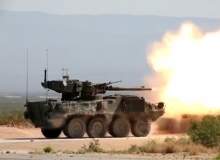
Lockheed Martin digital training ranges
Lockheed Martin has developed a Digital Range Training System, (DiRTS), for the US Army, designed to train and evaluate soldiers in the high-risk live-fire environment. They consist of instrumentation systems that allow army units to plan, coordinate execute and control gunnery training.
Crews of armoured vehicles can work alongside helicopters and dismounted soldiers, aiming at up to 400 digitally operated targets. Their performance is captured on camera to be evaluated in movie-style after-0action reviews.
One type of DiRTS, known as Battle Area Complexes (BACs), support Stryker brigade combat teams and cavalry regiments with 285 targets including vehicles and stationary or moving troops
The newest range, Digital Air-Ground Integration Range (DAGR), is the first to support army aviation gunnery training and integrate air and ground assets. It has an aerial weapons scoring system provides training results to better qualify air-to-ground performance.
Future ranges are likely to follow suit, incorporating live fire in a digital environment to best prepare troops for combat.
Sikorsky rolls out S-97 Raider
Sikorsky has unveiled its vision of what its future S-97 Raider multi-mission helicopter could look like. Raider is based on technology the company developed through its experimental X2 programme. It will be able to cruise at speeds of more than 220 knots, fly at 10,000 feet and operate at 36 degrees Celsius.
Unlike other helicopters, it can point in directions other than that in which it is flying. It can manoeuvre in such small spaces it could even be used down urban streets. In addition to being ideal for ‘sneak and peek’ manoeuvres, it can also deliver ground troops really quickly to add another stealth element. It is designed for light assault, light attack, armed reconnaissance, close-air support, combat search and rescue, and unmanned missions for both conventional US Army and Special Operations units.
If Sikorsky is to be believed, this future helicopter could be the answer to all future combat helicopter needs.
Royal Navy’s new offshore patrol vessels
While Raider remains on the drawing board so far, BAE Systems’ new offshore patrol vessels, or OPVs, for the Royal Navy are being built right now. The original River class vessels were introduced in 2004, but this batch 2 design has been stretched to 90m to include a Merlin-capable flightdeck.
In 2014 the Royal Navy awarded BAE Systems a £384 million contract to construct three of them. The first, HMS Fort, is under construction in Glasgow and will be commissioned in 2017.
They have a 2000 tonne displacement, a maximum speed of 24 knots, a range of 500 nautical miles, and support a crew of 34. The armaments are a 30mm main gun and small calibre machine guns, controlled through a CMS-1 combat system. They also carry two Pacific 24 model rigid inflatable boats or RIBS. They will be used for maritime security, disaster relief, search and rescue fire fighting.
Follow Berenice Baker on Google+


.gif)

